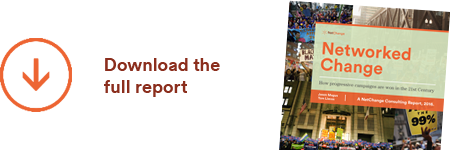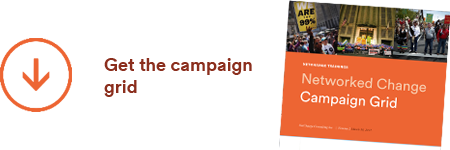A very interesting thing is happening right now, centered in Toronto but 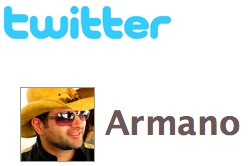 connected and relevant to the whole world. Last night, a digital executive named David Armano posted a story to his blog and sent a message to his Twitter network that has, as of a few minutes ago, raised over $14,000 in less than a day (he was at $5K in less than 2 hours) for his cause. This is an exciting story about new emerging models of social change, people's self-organizing capacity for creative response, and the power or networks.
connected and relevant to the whole world. Last night, a digital executive named David Armano posted a story to his blog and sent a message to his Twitter network that has, as of a few minutes ago, raised over $14,000 in less than a day (he was at $5K in less than 2 hours) for his cause. This is an exciting story about new emerging models of social change, people's self-organizing capacity for creative response, and the power or networks.
David's post was a plea to help a hard luck family get back on their feet, and his appeal to create an "apartment fund" really struck a chord with his community. From his original blog post:
I've been at this blog for nearly 3 years now and have never asked for something like this-I hope I've earned enough trust to be able to ask something back from you. Above is a picture of Daniela and her family. Brandon, age 6, Daniela, age 9 and little Evelyn age 4. Daniela is divorcing her spouse after years of abuse. In recent years her mortgage went unpaid and she's lost her house.
As of this moment, Daniela's family is staying at our house and we are trying to help her find a one bedroom apartment for her family to live in. With Evelyn, her youngest having Down's Syndrome and Daniela herself being a Romanian immigrant with very little family support she literally has no one to turn to. Except us (all of us).
His Twitter page tracks the amazing progress of this meme spreading around the world in real time. This below snapshot is earlier this morning (about 12 hours after he first tweeted + blogged about it).
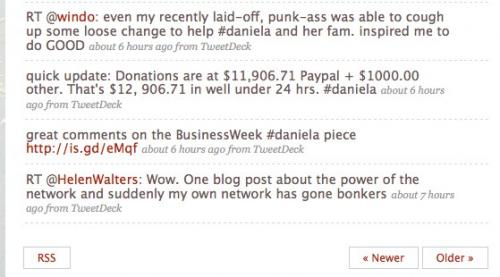
If you don't yet speak Twitter (don't worry, no one did even a year ago), the "@personsname" refers to other Twitter users he is "writing back" to. "RT@personsname" is re-publishing something that another person wrote, helping it go viral. Together, these blends of "micro-blogs" from David and responses from his community make up an interesting private / public conversation, happening in real time, and it's fascinating!
A friend of mine, Joseph Dee who is a new collaborator at the Social Innovation Group at MaRS, helped kick this whole thing off, and he pinged me with the story last night he was so excited. Since then I've spent a bit too much time today looking at it, and here is my 15 minute analysis on why it worked:
- David is a high profile, highly followed blogger and twitterer (8,300 followers)
- he's a VP at a big Toronto based digital agency, so knows his digital stuff
- his community aren't your typical NPO donors: prob not that engaged in traditional causes, and many of them would be young, hip, and have some extra cash (still)
- the story is all about authenticity: you get it, you believe it, you are moved by it, quickly
- the photo is pretty attractive
- momentum breeds more momentum. I heard about it b/c it's been such a sensation, etc etc.
A colleague at Free Range Media just forwarded me a story she wrote for the Non-profit Times about "Tweetsgiving" and "Twitter Vote Report" and what made them successful. There's definitely a trend here, and the attributes seem to be similiar in each case.
An even better connection is the hugel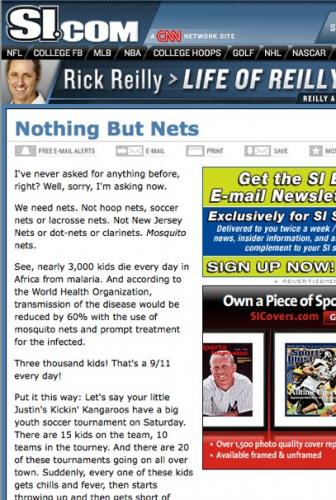 y successful NothingButNets.net campaign that the UN Foundation launched. It started when Rick Reilly, a somewhat obscure but well known in his community Sports Illustrated writer wanted to make a difference, and he asked his readers to do something for the first time in 16 years of writing. They responded with over $1M in donations. 3 years later the campaign, properly designed after the initial bump, has raised over $23M.
y successful NothingButNets.net campaign that the UN Foundation launched. It started when Rick Reilly, a somewhat obscure but well known in his community Sports Illustrated writer wanted to make a difference, and he asked his readers to do something for the first time in 16 years of writing. They responded with over $1M in donations. 3 years later the campaign, properly designed after the initial bump, has raised over $23M.
The attributes that were similar to this one:
- someone who was influential, respected, but not huge, famous, or overdone, led it as the chief storyteller, and was very engaged
- had never asked his readership to do anything before, so people who arent' fatigued
- his readership were not your typical NPO donors (75% of original donors were male!)
- it was a simple ask, simple story, you could not argue with the logic of it
- it grew like wildfire, viral, fast, building on success and everyone wanted to be involved once it scaled
I think connecting with the kinds of donors @Armano has found here is huge: telling a compelling story, appealing to conventional people's desire to help, dealing with their (sometimes deep) mistrust of big brand institutions, showing total transparency on how money is spent, spreading the word using the tools of our time, and keeping people engaged through those same tools is one of the biggest prizes & challenges of our time.
There's a LOT of people like this out there and they aren't members of Greenpeace/Amnesty/UNICEF/Children's Hospital, but they do want to make a difference in our crazy world.
The opportunity is ours to reach them.






